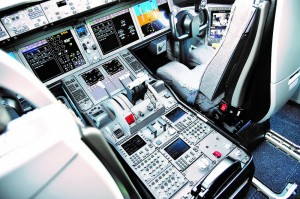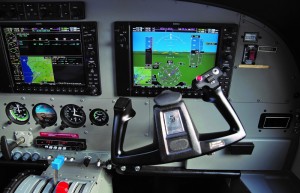How to Manage Automation and Handle the Unexpected
by Julie Boatman Filucci / Flying August 12, 2016
 Aircraft and avionics manufacturers and industry experts are trying to identify the best ways to trickle down Fourth Generation airliner advances in automation to appropriate levels for GA flying.
Aircraft and avionics manufacturers and industry experts are trying to identify the best ways to trickle down Fourth Generation airliner advances in automation to appropriate levels for GA flying.
Modern commercial aviation marvels us daily with its enviable safety record. Pioneers such as Donald Douglas, William Boeing and Dutch Kindelberger pursued passionately the operational consistency and reliability we see today as the world of commercial aviation continues to improve upon its stellar safety record with each passing year.
The ultimate achievement? A virtually accident-free system. The current crop of airliners, known as the Fourth Generation for their highly automated architecture and flight-envelope protection, plays a large role in the quest toward perfect safety. While not quite within our grasp in general aviation, we would all like to see similar improvements in safety and dispatch reliability translate into our everyday flying.
To this end, our own cockpits have become increasingly automated as aircraft and avionics manufacturers and industry experts identify the best ways to trickle down advances in automation to appropriate levels for GA flying. Witness the advent of the lower-cost yet sophisticated autopilot, flight directors that utilize “highway in the sky” technology, and aircraft upset recovery systems such as the single blue button that can return a Cirrus SR22 to level flight on a given heading with one push. Do these tools add to our capabilities and the resulting safety net? Sure. But, just as within the airline environment, they can also turn us into pilots who monitor and manage more than we fly, and if not used properly within the context of a given flight, they may leave us detached from the airplane when the unexpected occurs.
The atrophy of manual flying skills has been identified as partially to blame for accidents.
How does this happen? We can uncover the reasons by examining an unfortunate trend in the airline world. According to aviation regulatory agencies such as the FAA and EASA (European Aviation Safety Agency), while the overall airline accident rate remains low, there has been a steady rise in the number of accidents that can be attributed to the inability of the flight crew to assess and understand an unexpected situation and respond appropriately — particularly when the transition from automated to manual flight was involved.
The atrophy of manual flying skills has been identified as partially to blame for accidents. High-profile crashes, such as Asiana Flight 214 that landed short of the runway at San Francisco and Turkish Airlines Flight 1591 that suffered an improper stall recovery into Amsterdam, show the worst outcomes. Most recently, the crew of Flydubai Flight 981, which crashed in southwestern Russia in March, is now known to have been hand-flying when the airplane pitched down and descended into the ground. The accident occurred during the last of multiple attempts to reach a destination late at night in poor weather, conditions when the appropriate use of automation — and, more importantly, strategic and structured decision-making — can strongly assist a crew.
We have witnessed similar accident profiles in GA’s advanced technology aircraft in which the pilot has been trained to fly using the autopilot, GPS and other cockpit tools and becomes complacent or overly reliant upon the automation to handle the most complex parts of the flight. One common example occurs during an instrument approach, particularly at night, and/or with weather close to IFR minimums. Any surprise event can startle the pilot, and the result may not be pretty.
A Cirrus SR22 accident in Minocqua, Wisconsin, in 2008 demonstrates how a lack of fluency in autopilot-to-manual transitions — and an inability to cope with an intensifying situation — can bite a pilot during one of the most critical phases of flight: the missed approach initiated at low altitude under IMC.
When confronted with ceilings close to minimums on a non-precision approach into Lakeland Airport (KARV), the pilot initially flew the approach using the SR22’s autopilot (an S-Tec 55X, in this configuration, linked to the Garmin GNS 430 and the Avidyne Entegra EX5000 primary flight display). When he transitioned to hand-flying, apparently during the final approach segment, he lost control and crashed near the runway.
Modern cockpits make flying easier and, in most cases, safer. But, for some, ease promotes complacency.
A comprehensive study commissioned by the European Union titled “Manual Operation of 4th Generation Airliners” conducted between September 2012 and December 2015, examined the problem within the commercial aviation sphere. Known in shorthand as Man4Gen, the project brought together groups from Boeing and Airbus, along with several European university research programs and safety initiatives, to investigate how crews react to unexpected situations and manage the automation and any transition to hand-flying to rectify the problem. The report, which came out earlier this year, made training recommendations for airline crews and suggested a checklist-style tool that pilots can use to effectively manage complex situations.
Staying ahead of the airplane is critical, serving as an antidote to inevitable surprise events and the confusion they may cause. In addition, training for those surprise events — so that you accept the likelihood of surprise — becomes a key focus area and just as important as knowing how to engage and manage the automation smoothly. While industry has put forth checklists (such as the DECIDE model) for aeronautical decision-making, on the whole these lists have not been effectively taught nor particularly useful in the cockpit, typically being too vague and convoluted to apply under all circumstances.
That’s why the Man4Gen project proposes a strategy, a method of dealing with unexpected situations that can help a pilot or flight crew navigate complex, often ambiguous, and dynamic scenarios in flight. The term was chosen specifically so as not to signal a step-by-step, linear checklist. Instead, it is designed to become a part of pilot training, specifically for airline crews. But its methodology appears equally applicable to single-pilot general aviation operations.
“Tools like these need to be trained thoroughly because rational and structured decision-making is not something humans do instinctively,” says Edzard Boland, training and operator performance specialist for Netherlands Aerospace Centre (NLR), the consortium leader on the project. “The main goals of using these tools should be structured decision-making, including flight-option generation, risk assessment and contingency planning.” The upshot is that, when practiced on every flight, these processes become your learned responses to unexpected situations.
The Man4Gen Decision-Making Tool
You can improve your own decision-making fluency through practice, using key elements of the airline-centric Man4Gen tool either in the airplane or a flight-training device or simulation program.
Adapted from the Man4Gen Complex Situation Management Guide
STABILIZE FLIGHT PATH
Fly the aircraft.
Confirm flight path control.
Consider use of the autopilot (if not already engaged), particularly if operating as a single pilot.
Assign a “pilot flying” and “pilot monitoring” if operating with two pilots on board.
MANAGE IMMEDIATE THREATS
Identify immediate threats.
Prioritize threats.
Follow checklist memory items for threats in order of priority.
Confirm threat status.
MAKE A SHORT-TERM PLAN
If possible, maintain flight and buy yourself time.
Consider flight-plan options, including the original and alternate destinations, and hold or land as soon as possible.
Confirm the short-term plan if flying with a second pilot.
Consider notifying ATC and/or passengers.
IDENTIFY THE SITUATION
Acknowledge certainties, uncertainties and concerns. Consider fuel limits, structural integrity, controllability, performance, reliability of information, secondary failures, and external factors such as weather, traffic and destination concerns.
Cross check the suspected situation.
If several possibilities exist, prepare for the worst-case scenario.
Perform Appropriate Actions
Assure that actions will be safe, effective and informative with reliable data.
Perform procedures and other actions.
Verify the effect or knowledge gained from these actions.
DEVELOP A LONG-TERM PLAN
Identify the effects of the situation.
Adapt monitoring to detect important changes and avoid fixating on one part of the situation.
Consider regular flight-planning tasks such as weather, arrival planning and passenger briefing.
Confirm the long-term plan if flying with a second pilot.
Notify ATC if appropriate.

